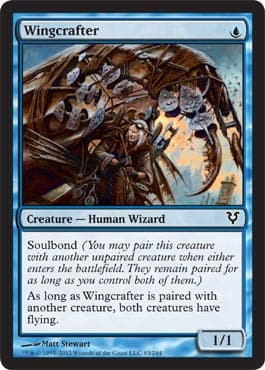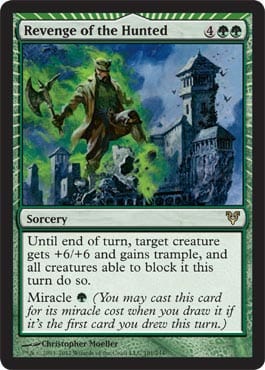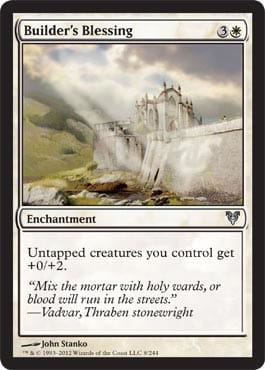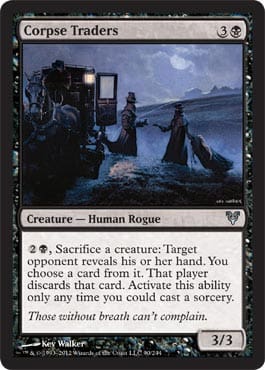Last week’s article didn’t make it up due to some logistical issues, but for those of you dying to know how the cards tested, don’t worry; it’ll go up alongside something else in a couple of weeks. In the meantime, word on the street is that there’s some sort of exciting new set that you played with for the first time last weekend. Let’s talk about that.
Standard Deviation
Before we get to talking about cards, mechanics, or even themes, I want to address Avacyn Restored’s size. Releasing a large third set has a lot of impacts, most of which Zac Hill covered in his article on the mother ship last Friday, but I want to spend a bit more time on the size of Standard.
The advent of the mythic rarity and the compression of set sizes that took place in Shards of Alara was a direct response to the overwhelming nature of Time Spiral/Lorwyn Standard. Between the four-set mega-block, Time Spiral’s timeshifted sheet, and Coldsnap, there were more than twenty-one hundred different cards in the format. That’s nearly a third of Modern!
Needless to say, that size was a bit intimidating for new players, but after shrinking Standard down to thirteen hundred cards, Wizards found that the change had been more drastic than it needed to be. They’ve since increased the size of the card pool through liberal adjustments to set sizes like New Phyrexia’s extra uncommon slots and Innistrad’s double-faced sheet. In fact, come Friday, Standard will be within one hundred fifty cards of its size from the Mirrodin/Kamigawa era, and Return to Ravnica has been announced to have two hundred seventy-four cards as opposed to the usual two hundred forty-nine. At first, one might assume R&D has simply gotten lax; after all, it’s hard to cut cards from the file.
I guarantee you that this is not the case.
The people who make this game care far too much about it to let things like that fall through the cracks. No, the blame lies with Magic Online and the StarCityGames Open circuit. Far more Standard is being played now than ever before, and as such, people become tired of the top decks much more quickly than they did in the past. The same change that led to the printing of Grafdigger's Cage in the middle of its block has necessitated larger Standards to ensure flexibility.
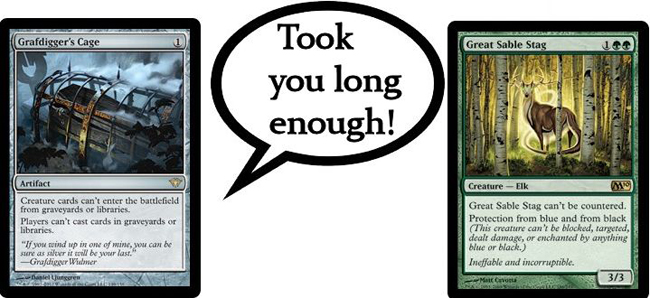
But the issues that led R&D to shrink the format in the first place haven’t disappeared, and growing Standard poses a threat to the format’s current status as both an introductory and competitive environment. Luckily, format diversity doesn’t really depend on the size of the card pool; it depends on the number of playable cards. Ravnica/Kamigawa Standard had a very flat power curve, and as a result, it was a very open Standard format, but that model also has its drawbacks.
A format full of Jace, the Mind Sculptors and Primeval Titans may exclude archetypes that can’t abuse them, but it also gives inexpert deck-builders direction (and a fighting chance). Clearly we don’t want to unmake the recent strides forward in this area, but neither do we want monolithic best decks always ruling Standard. Finding balance will require some sort of middle ground in which the obviously powerful cards can fit into a multitude of different archetypes without gooodstuff.dek becoming top dog. I don’t know if it can be done, but at this point, I’m not sure where else to turn.
More to the Point
Well, I’ve spouted my mouth off quite enough about the role of set size in development; let’s get back to the set at hand. In the fifth stage of design, blocks are experiences. They have themes, but those need not be mechanical, so while Innistrad has plenty of cards that care about the graveyard, it’s not a graveyard block as Odyssey was. Innistrad is a horror block (or at least the first two sets were).
Most of the time, we enter pastoral planes just as cataclysms are about to strike, but we came to Innistrad with things already looking pretty grim. We fumbled in the dark, chased by monstrosities, and things were only becoming worse as our friends disappeared and blood drenched the walls. But Avacyn Restored . . . Avacyn Restored is DAWN. The cards—and more importantly, the set’s gameplay—are filled with teamwork, hope, relief, and success. So, how did they do it?
The Name’s Bond
Let me start by saying that soulbond is a brilliant mechanic. It’s not so much the concept as the execution that wows me; you see, the idea wasn’t a new one to me. When working on Neale Talbot’s Twitter set, we were looking for a mechanic to signify love, and Chah came up with a bunch. In the ensuing discussion, Wobbles proposed something very similar to the version of bond that came out of design (only triggering when the creature with the ability enters the battlefield), but it didn’t seem feasible.
Nobody came up with a clean method of restricting bonding to pairs, and without that limitation, it would make undecipherable board states. Wizards solved that problem simply by adding to the game’s rules. That’s one of my weakest points as a designer; I’m so used to thinking of the rules as a fixed framework that I don’t see the solutions offered by expanding them.
Speaking of soulbond rules, they’re evidently quite confusing. I judged two local prereleases last weekend, and I was asked two questions about miracles and about twenty regarding soulbond. Everything in design is a tradeoff, and decreasing soulbond’s comprehension complexity would have required worse gameplay, but Avacyn Restored has a bit more overall complexity at common than I’d like to see.
I hope the mechanic will prove to be worthwhile, and I think it has a very good chance of doing so—it delivers on so many axes. Perhaps soulbond’s biggest accomplishment is offering the same fun of building your own creature without the card disadvantage of Auras or the repetitive gameplay of Equipment. Fixing Auras is more or less a holy grail of Magic design, and because of its apparent success in doing so, I expect soulbond to return early and often.
Just a Moment
If you’d told me about Avacyn Restored two months ago, I’d have given you a funny look when you let me know that the set has a flickering theme. The mechanic confuses a lot of players who don’t understand how it stops Doom Blade, and bounce spells manage to fill a lot of the same roles with less confusion.
Looking back at it, my perplexity is a sure sign that I failed to take New World Order to heart. I understood the need for simplicity, but Magic players aren’t dumb. It’s not that we can’t make complex interactions, but that the complexity we create at common should be focused in one vein so that players can figure out what’s going on. Once we’re past that hurdle, flickering does all sorts of cool things with soulbond, undying, and the good guys’ enters-the-battlefield triggers as well as protecting your big Angels.
It’s a . . . Wait, Somebody Already Made That Joke?
Miracles fill a very strange role in terms of player perception. Brand new players don’t really know how good it is to save 5 mana on a Temporal Mastery, and they may never have heard of Time Walk. Those who’ve played for a while but aren’t good at analyzing probabilities see the under-costed effects they could be getting and are super-excited, and those who play at a high level recognize that how often the card’s effect is dead changes the mana-cost math, and they end up unexcited by the inconsistent miracles.
There’s been a lot of talk about the cards, and most of the more casual players at my local shop seemed excited by their miracles, but I was a bit disconcerted that they didn’t excite me in gameplay even though I’m an adrenaline Timmy. That may have been due in part to the fact that both of my Sealed pools last weekend contained not just Sigarda, Host of Herons, but also Angel of Glory's Rise, which served a much more miraculous role.
I know, I know: I run good. But my point is that I found myself hoping to draw one more land, some bomb creature, a chump-blocker, or a removal spell much more often than I was hoping for a miracle, and if that reaction is widespread, it’s a definite problem for the mechanic. I’ll be listening as everyone continues to explore the Limited environment, and I’ll try to figure out if they’re playing well in addition to creating Magical Christmas Land scenarios.
I Will Survive
When choosing a carryover mechanic to exemplify the monsters, the only two real choices were double-faced cards and undying. I suspect Wizards chose undying as a way to cut their losses if DFCs proved unpopular, but whatever the motivation, the end result was a good one. My gripe with the monsters has to do with color distribution. The black cards in Avacyn Restored feel as though they’re part of Innistrad, and most of the rest feel like a whole new block in the same setting (think Onslaught and Odyssey). This divide made looking over my Sealed pools this past weekend one of the most jarring Limited experiences of my Magic career. The design mirrors pretty well, so I think the issue may stem from different tones in the card art, and a few more Evernight Shades instead of Corpse Traderss could have helped.
 |
Okay, okay, you probably didn’t come here for an art critique; what about the Limited format?
Permanent Marker
Like Rise of the Eldrazi, Avacyn Restored offers little in the way of catchall removal. That choice allows all of the Angels to be awesome instead of just dying, but unlike Rise, this set has some truly aggressive archetypes. Cutting the removal makes blocking the only way to stop an early rush, so cutting back on removal also requires shaving Nightbird's Clutches and Silent Departures to keep the slow decks from being overrun. But once you’ve gotten rid of all of that, it’s very hard to beat bombs. The development team seems to have looked to remedy this issue by bolstering synergistic Limited decks, but that only really solves the problem in Draft. Going forward, I’ll be interested to see if Sealed play really becomes as miserable as some of the pro players seem to think it is right now.
A Lonely Mechanic
Over the course of the weekend, I never had a chance to play with or against any loners, though a friend of mine found success under a Demonic Taskmaster. The cards look unappealing because of their drawbacks, and I’d bet that plenty of people who should have been playing them weren’t as a result. That would normally be fine, but in a set that running dangerously high on complex themes, I’d really like the simple ones to appeal to new players . . . and this one certainly doesn’t.
The Devil’s in the Details
There’s a lot going on in Avacyn Restored, and we haven’t even gotten to the individual cards! Next week, I’ll point out some of the most masterfully designed, most problematic, and most interesting cards in the set, but in the meantime, I’d love to hear your opinions on Innistrad’s finale. Have a great time at your launch parties!
















